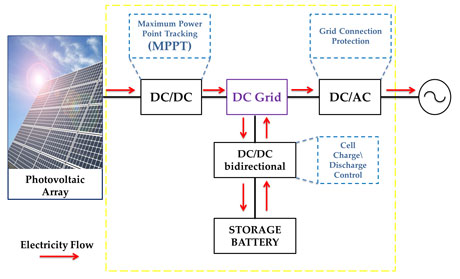by Alessio Iovine, Sabah Benamane Siad, Abdelkrim Benchaib and Gilney Damm
New connection constraints for the power network require more flexible and reliable systems, with robust solutions to cope with uncertainties and intermittence from renewable energy sources (renewables), such as photovoltaic arrays. The interconnection of such renewables with storage systems through DC links can fulfill these requirements. A “Plug and Play” approach based on the “System of Systems” philosophy using distributed and adaptive control methodologies is being developed.
Renewable energy can play a key role in producing local, clean and inexhaustible energy to supply the world’s increasing demand for electricity. Photovoltaic conversion of solar energy is a promising way to meet the growing demand for energy, and is the best fit in several situations. However, its intermittent nature remains a real disability that can create voltage instability for large scale grids. In order to offer an answer to the new constraints of connection to the network (Grid-Codes) it is possible to consider a storage system; the whole system will be able to inject the electric power generated by photovoltaic panels to the grid in a controlled and efficient way. As a consequence, a strategy for managing energy in relation to the load and the battery constraints will be needed.
The approach is based on a “Plug and Play” philosophy: the global control will be carried out at local level by each actuator, according to the distributed control paradigm. The control objective is to develop a distributed method for stabilizing each part of the whole system, while performing power management in real time to satisfy the production objectives and assuring the stability of the interconnection to the main grid. Furthermore, this system may bring support (voltage and frequency) to the main grid by additional control schemes.

Figure 1: Photovoltaic system with storage.
The whole control objective is then split in several tasks; the first is to increase the efficiency of the photovoltaic array, which should work in its maximum power point for delivering the maximum amount of energy. Maximum Power Point Tracking (MPPT) algorithms are used to compute the desired voltage that assures this maximum power production. A drawback is the uncertainty of doing this without irradiance and temperature sensors. An adaptive control scheme that is capable of achieving maximum power point tracking for changing environmental conditions can be used instead [1]. This system estimates parameters that depend on irradiance and temperature, increasing the robustness of the system and eliminating the need for a sensor.
A second step is to stabilize the DC/DC boost converter that connected the solar array to the DC network, calculating the optimal value of the duty cycle [2]. Lyapunov theory is used in this task, taking into account the parameters' estimator dynamics.
The focus then moves to the storage system and its connection to the DC network. Lead-acid batteries are commonly chosen as a storage system, and a DC/DC bidirectional converter is necessary to enable the two modes of functioning (charge and discharge) [2]. The regulation of the battery current and voltage consists of a cascade control; again, Lyapunov theory is used for providing stability. An algorithm that helps to manage power by defining priorities in relation to the load and the constraints of battery operation is also required.
With this structure, the DC grid is able to provide a continuous supply of good quality energy. Finally, the DC network must be interconnected with the AC grid, and must be controlled in such a way that it offers support (ancillary services) to the grid.
The final management system can be configurable and adaptable as needed. The battery is assimilated as a reservoir which acts as a buffer between the flow requested by the network and the flow supplied by the production sources, and its voltage is controlled by the DC/DC current converter. The three converters present in this system must, in a decentralized way, keep the stability of the DC network interconnecting all parts.
The whole system provides protection against faults and suppresses interference, and has a positive impact on the behaviour of the complete electrical system.
Link: http://www.hycon2.eu/
References:
[1] F. Jaramillo-Lopez, G. Damm, G. Kenne, F. Lamnabhi-Lagarrigue: “Adaptive control scheme for maximum power point tracking of a photovoltaic system connected to the grid”, 2013 European Control Conference (ECC), Zürich, Switzerland.
[2] S. Benamane Siad: “Gestion des flux énergétique dans un système photovoltaïque avec stockage connecte au réseau”, Master thesis report, Alstom-Cnam, July 2012.
Please contact:
Alessio Iovine
University of L’Aquila, Italy
E-mail:
Sabah Benamane Siad
Bouygues Energies et Services, France
E-mail:
Abdelkrim Benchaib
ALSTOM GRID, R&D Department, France
E-mail:
Gilney Damm
Université d'Evry Val d'Essonne, France
E-mail:











